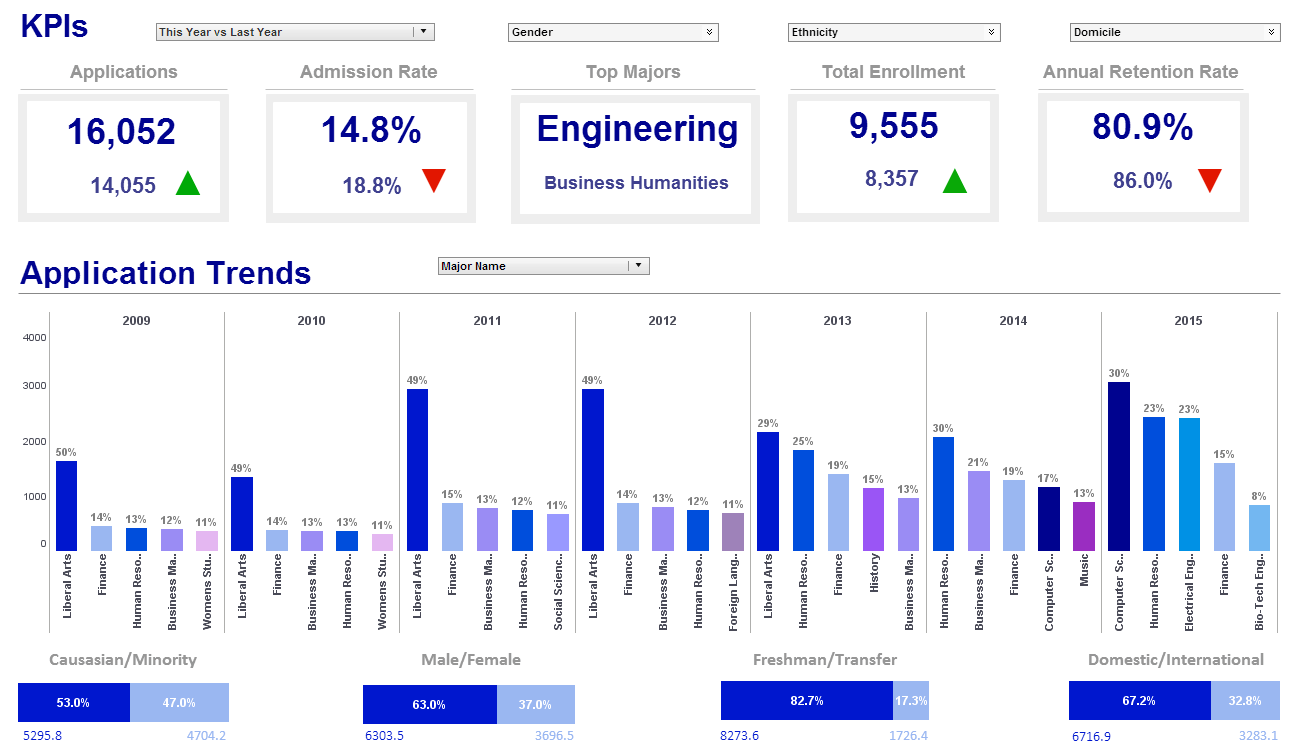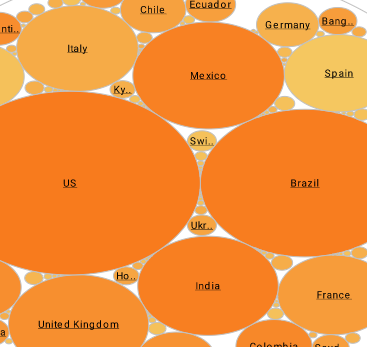Information About Key Performance Indicators Dashboard Solutions
Are you investigating key performance indicators dashboard solutions? InetSoft offers performance management software for dashboards and scorecards that can be easily deployed and used. Read articles below about performance management topics and the features and benefits of InetSoft's KPI tools.
Hospitality Businesses Use Data Analytics - Easier data analytics has tremendous potential in the hospitality industry, but are you taking advantage of it already? If not, you better think about it soon because your competitors are probably using advanced data processing programs to create better offers for their clients. According to the report, the key benefits of implementing new technologies in the hospitality business include an increase in online revenue, reduction in guest complaints, and better customer service ratings. If data analytics can generate such impressive results, the only real question is how to make use of it and help your business flourish in the years to come. In this post, we will explain to you how to boost your hospitality business with data analytics in no time...
 |
Click this screenshot to view a two-minute demo and get an overview of what InetSoft's BI dashboard
reporting software, StyleBI, can do and how easy it is to use.
|
How Are Business Performance Management Systems Used in the Music Industry? - Business Performance Management (BPM) systems are used in the music industry to streamline operations, improve decision-making, and enhance overall performance. Here's some of the ways that BPM systems are used in the music industry: Revenue and Royalty Tracking: BPM systems help track music sales, streaming revenue, and royalties owed to artists, songwriters, and other rights holders. These systems provide real-time insights into revenue generation, helping music companies manage payments accurately and transparently. Tour and Event Management: BPM systems assist in planning, organizing, and managing music tours and events. They track event schedules, budgets, ticket sales, and expenses, ensuring that tours run smoothly and profitably. Artist Management: BPM systems support artist management by tracking contracts, royalties, tour schedules, and promotional activities. They help in coordinating various aspects of an artist's career, from music releases to marketing campaigns. Digital Distribution: Music distribution platforms use BPM systems to manage the distribution of music to streaming services, online stores, and other digital platforms. These systems facilitate the tracking of sales, streams, and user engagement...
How Are Business Performance Management Systems Used in Venture Capital? - Business Performance Management (BPM) systems are valuable tools in the venture capital industry for effectively managing investments, evaluating portfolio performance, and making informed investment decisions. Here's some of the ways that BPM systems are used in venture capital: Investment Analysis and Due Diligence: BPM systems assist venture capitalists in conducting thorough due diligence on potential investment opportunities. These systems can store and analyze financial data, market trends, and competitive landscape information, helping investors make informed decisions about whether to invest in a startup. Portfolio Monitoring: Venture capital firms often manage a portfolio of investments. BPM systems provide a centralized platform to track the performance of each investment in real-time. Metrics like revenue growth, user acquisition, and key performance indicators (KPIs) can be monitored to assess the health of portfolio companies. Financial Tracking: BPM systems enable venture capitalists to track the financial performance of portfolio companies, including revenue, expenses, profitability, and burn rate. This data helps investors understand the financial trajectory of each startup...
How Are KPI Reporting Tools Used in Professional Sports? - Key Performance Indicator (KPI) reporting tools play a crucial role in professional sports organizations by helping them track and analyze various performance metrics to improve team performance, player development, and fan engagement. Here are some KPI reporting tools commonly used in professional sports: Sports Analytics Software: There are various sports analytics software platforms that cater to different needs, such as Catapult Sports and Sportscode. These tools allow teams to collect and analyze data on player performance, game strategy, and injury prevention. Player Tracking Systems: Tools like Zebra Sports Solutions and Second Spectrum provide real-time tracking of players' movements during games. This data is used to analyze player positioning, speed, and distance covered, helping teams make data-driven decisions. Performance Analysis Software: Companies like Sports Insights and Instat provide software that helps teams break down game footage to analyze player and team performance. Coaches can use these tools to review specific plays and make tactical adjustments...
How Best in Class Organizations Do CRM - We’re talking about how best in class organizations do CRM. You have got to follow, what I would like to call the “bounciang ball” because if somebody starts out on the Website, and then gets stuck and calls a Customer Service Center, you don’t want the Customer Service Center to say, “What's your name? And what are you looking for?” You want them to say, “Well, let me pick up from where you are on the Web site.” If the customer then goes into the store, as my wife often does, she starts on the Web site, calls the call center and then goes in to buy clothes for the kids. And she has to start the whole thing over. I want blue jeans with flannel inside, green for the daughter and red for the son. So she wants them to follow her bouncing ball, and that’s normal for particularly today's type of customer or digital client that really is demanding this type of service. So we have got to capture insights from each one of these opportunities. Okay, and just a bit of academia for a moment. Why bother, and what's the key concept to make this whole thing happen? Here is just a very interesting insight. So the way you make multi-channel work, and I find this still very interesting, is you have one unified knowledge base, and it has common content, and that content gets shared across the different channels...
How BI Becomes Performance Management - Something like performance management is fairly strategic. You need to have business support, but literally the ownership has to be by senior management. It’s not something that an individual in the bowels of an organization can start to implement. So much of business intelligence is about building a data warehouse and giving users a tool. That’s all well and good, and for InetSoft, that is a successful sale, and the enterprise might actually get some value right away. But the question is does it really move the business forward? What are the users looking at? Maybe we’ll give them a dashboard. What should be in the dashboard? I don’t know, whatever the users want in that dashboard. Is there a cause and effect relationship associated with what’s in the dashboard? Well, often not. What is it we’re actually tracking? That’s why planning, for instance, is a real critical piece...
How Big Data Improves Yields in Agriculture - The agricultural sector is seeing major shifts in its supply chain, roles of different players and power relations between them, and the whole supply chain due to Big Data. Smart sensors and devices powered by the latest technologies like artificial intelligence, the Internet of Things, and Cloud Computing, accumulate massive volumes of data of different types that are revolutionizing the cyber-physical farm management cycle. Big Data is being used to: predicting the best practices in farming operations, supporting operational decision-making processes in real-time, and re-designing business processes to improve business models and develop innovative ones. Here are some of the latest trends in the world of agriculture that are emerging due to Big Data...
 |
Learn how InetSoft's data intelligence technology is central to delivering efficient business intelligence. |
How Can eCommerce Businesses Gain From Big Data - An amazing feature about being a writer on eCommerce is that one has to constantly keep on top of the latest concepts and technologies. On more than one occasion, this has led to me following the herd and falling for the hype. I wonder if that can possibly forgive the fact that I have thus far overlooked writing about the application of big data to eCommerce. It is time for me to right this wrong. What Is Big Data? A textbook definition would be much more rigorous, but think of big data this way: every time a user interacts with your website, you collect data. This data could be the kind that is entered in a form or created in the background. Some background data on an eCommerce website could be...
How Can Software Be Robust? - Robust software is software that is able to function correctly in a wide range of situations, even when faced with unexpected inputs or conditions. This can include things like handling errors and unexpected user input, dealing with large data sets, and continuing to function correctly even when faced with hardware or network failures. One of the key principles of robust software design is to anticipate and plan for potential failure points. For example, a robust program will have built-in error handling mechanisms to deal with unexpected inputs or conditions, such as input validation to ensure that a user is entering valid data, or a mechanism for dealing with unexpected exceptions or errors. This helps to ensure that the program can continue to function correctly even when faced with unexpected situations. Another important aspect of robust software is the ability to scale and handle large amounts of data. This can include things like efficient algorithms for processing data, as well as the ability to handle large numbers of concurrent users or requests. In addition, robust software should be able to adapt to different hardware and network configurations, and be able to continue functioning correctly even when faced with hardware or network failures...
How Data Mining Helps Strengthen Your Instagram Marketing Strategies - In today's digital age, social media have become much more than social networking channels. Now, they're potent places for businesses to expand their reach and boost brand awareness with marketing videos, social posts, and any other content. Among these platforms, Instagram stands out as a vibrant marketplace where businesses can showcase their products or services to millions of users worldwide. However, with millions of posts being uploaded daily, standing out and reaching the right audience can be challenging. This is where data mining comes into play, offering valuable insights to help businesses increase sales on Instagram. Let's dive deeper into Instagram data mining and how it actually boosts your overall Instagram marketing strategies. In the social media realm, data mining involves extracting valuable information from social data. It goes beyond a company's or research firm's internal databases and systems. Also, this process typically entails gathering, refining, and examining raw data acquired from popular social media platforms like Facebook, Instagram, Twitter, TikTok, LinkedIn, YouTube, and more...
 |
Learn the advantages of InetSoft's small footprint BI platform. |
How Developers Are Using Machine Learning for Mobile Apps - Conceived in 1959, machine learning entered the mainstream in recent years in combination with predictive analytics and artificial intelligence. Its developer, IBM's Arthur Samuel, had no mobile apps with which to use his concept, but today's programmers do. Increasingly, they leverage machine learning to provide their apps an edge. That edge - the ability to adapt, learn, and improve - lets the application continually develop without needing constant updates from the developer. A mobile app's ability to learn frees its programmers from the requirement of constant development of new releases. It also helps keep mobile apps small. It is impractical to expect a programmer to create code to address every possible scenario since any app that code-heavy would no longer fit on a cell phone or tablet. Machine Learning Defined The technology machine learning lets electronic devices process, analyze and self-actualize data. This learning extends to trend identification, pattern analysis and action implementation to fulfill an objective. One of its key benefits is increased efficiency resulting in updated programming without increased development costs or timeframes. Businesses investing in the use of machine learning are expected to double in the next three years, reaching an uptake of about 64 percent of businesses. Allied Market Research predicts the service market of machine learning will reach $5.537 million by 2023 and grow at a CAGR of 39 percent during the period 2017 to 2023...
How Do Actuaries Use Data Reporting Tools? - Actuaries are professionals who use mathematical and statistical techniques to assess and manage risks. They use data reporting tools to analyze large amounts of data, make informed decisions, and help organizations manage risk. Here are some specific ways actuaries use data reporting tools: Data analysis: Actuaries use data reporting tools to analyze large datasets and identify trends and patterns. They can then use this information to make predictions about future events, such as the likelihood of an accident or the cost of a claim. Risk management: Actuaries use data reporting tools to assess and manage risk. They can model different scenarios and predict the impact of various risks on an organization's finances. Financial reporting: Actuaries use data reporting tools to create reports that communicate complex financial information in a clear and concise way. They can use charts, graphs, and other visualizations to help stakeholders understand the financial health of an organization. Insurance pricing: Actuaries use data reporting tools to help determine insurance premiums. They analyze data on past claims and use statistical models to predict the likelihood of future claims. This information is then used to set premiums that are appropriate for the level of risk. Fraud detection: Actuaries use data reporting tools to identify patterns that may indicate fraud. They can analyze large datasets to identify anomalies and flag suspicious activity...
How Do Java Developers Use Performance Management Software? - Java developers can use performance management software to track their progress towards goals, identify areas for improvement, and make informed decisions about their career development. Here are some of the specific ways that Java developers can use performance management software: Set and track goals: Java developers can use performance management software to set specific, measurable, achievable, relevant, and time-bound (SMART) goals. They can then track their progress towards these goals and make adjustments as needed. Identify strengths and weaknesses: Java developers can use performance management software to identify their strengths and weaknesses. This can help them focus on areas where they can improve and develop new skills. Get feedback from managers and peers: Java developers can use performance management software to get feedback from their managers and peers. This feedback can help them identify areas where they can improve and make adjustments to their work accordingly...
How Do Operations Analysts Use Performance Management Tools? - Operations analysts are professionals who analyze and improve the performance of an organization's operations. They use various tools and methods to measure, monitor and optimize operational efficiency, quality, customer satisfaction and profitability. Some of the common tools that Operations Analysts use are: Operational Performance Management (OPM) software: These are programs that help track and manage key performance indicators (KPIs), goals, objectives and strategies for different operational areas. They also provide dashboards, reports and alerts to visualize and communicate performance data OKRs: These are Objectives and Key Results, a goal-setting framework that helps align and measure progress across teams and individuals. OKRs help define what needs to be achieved (objectives) and how to measure success (key results) OGSM: This is Objectives, Goals, Strategies and Measures, a strategic planning tool that helps create a clear and concise plan for achieving a vision. OGSM helps define the desired outcomes (objectives), the specific targets (goals), the actions to take (strategies) and the metrics to track (measures)...
How Do You Go About Getting That Final Third of KPIs? - Projects have to be created for them. But naturally you have to estimate the effort that is required to get that data and compare it to the value you will get by having it. Some won’t pass the test. Sometimes you can think of proxies or near-equivalents that you can measure. Sometimes the answer is a customer survey done on a periodic basis. You won’t have 100% coverage or high frequency, but it’s a good estimate that is better than none at all. These challenging ones just have to be worked on one at a time, and gradually you’ll get near the end goal. But don’t feel like you have to get to 100% completion, and realize other KPIs will come up over time as the business evolves. How do you cope with the evolving needs and desires of business KPI dashboard users? It will always be the case that after you get the first dashboards out the door, end users will think of other KPIs that could be tracked. Or people will realize that some of the metrics first decided on are not actually the right ones, as it turns out...
 |
View live interactive examples in InetSoft's dashboard and visualization gallery. |
How Do Operations Analysts Use Performance Management Tools? - A defense operations analyst is a professional who analyzes and improves the performance of an organization's defense operations. They use various tools and methods to measure, monitor and optimize operational efficiency, quality, security and effectiveness. Some of the common tools that defense Operations Analysts use are: DOD Performance Management and Appraisal Program (DPMAP): This is a performance management system that covers the majority of DOD employees. DPMAP uses a process for planning, monitoring, evaluating and recognizing employee performance while linking individual employee performance to organizational goals Data Analytics: This is a cross-cutting analysis of DOD acquisition by commodity type, contract, contractor, contractor incentive, portfolio and individual program using data mining principles, analytic tools, data scientists and functional subject matter experts DCIPS Performance Management: This is a performance management process that uses six performance elements for DCIPS employees: Accountability for Results, Communication, Critical Thinking, Engagement and Collaboration, Personal Leadership and Integrity, Technical Expertise...
How Does a Company Manage the Performance of a Call Center? - Managing the performance of a call center involves a combination of strategies, processes, and tools to ensure operational efficiency, agent productivity, and customer satisfaction. Here are some key steps and approaches that a company can take to effectively manage the performance of a call center: Define Clear Objectives: Set specific and measurable performance objectives aligned with the company's overall goals. These objectives may include targets for key performance indicators (KPIs) such as AHT, FCR, SLA compliance, CSAT, etc. Implement Performance Management Systems: Deploy robust call center management software or performance management systems that capture and analyze data related to call center operations and agent performance. These systems help track KPIs, generate reports, and provide insights for decision-making. Set Performance Targets: Establish realistic and challenging performance targets for individual agents, teams, and the call center as a whole. Clear targets provide a benchmark for performance evaluation and help drive continuous improvement efforts. Monitor Performance in Real-Time: Utilize real-time monitoring tools to track call center activities, agent performance, and adherence to service level targets. Supervisors and managers can identify issues promptly and take immediate corrective actions if necessary...
How Does a Fraud Operations Analyst Use Dashboards? - A Fraud Operations Analyst can use dashboards to monitor key performance indicators (KPIs) related to fraud detection and prevention. Here are a few examples of how a Fraud Operations Analyst can use dashboards: Transaction Monitoring: Dashboards can display real-time information about transaction volumes, values, and types. A Fraud Operations Analyst can use this information to identify unusual transaction patterns and take immediate action to prevent fraud. Fraud Incidents: Dashboards can display information about fraud incidents, such as the number of incidents, the types of fraud, and the total value of losses. This information can help a Fraud Operations Analyst to identify trends and patterns that require further investigation. Alert Management: Dashboards can display information about alerts generated by fraud detection systems. A Fraud Operations Analyst can use this information to prioritize alerts based on their severity and take appropriate action to investigate and prevent fraud. Investigation Status: Dashboards can display information about the status of fraud investigations, such as the number of investigations, the average time to resolution, and the success rate of investigations. This information can help a Fraud Operations Analyst to identify areas of improvement in the investigation process...
How Does an IT Organization Support a KPI Project? - Sometimes, when these initiatives are being driven by the Business, some IT organizations might look at it as just another job, and they don’t need any more jobs. You know those marketing people want more metrics, they’re forcing a BI application on us, we don’t get any value out of it, and it’s one more application to care for and feed. We have less people, we don’t need this. The more progressive IT organizations who are thinking ahead, have taken the driver’s seat and look at things totally differently. They say, all right, how can we also get something out of this BI solution, how can we help pick the solution that’s going to help the business the most...
How Does a Legacy System Affect the Process of Setting Up Machine Learning Solution? - One last question which is probably on the minds of many of our listeners is how does a legacy system affect the process of setting up machine learning solutions? That's a question that I get a lot from our installed base. InetSoft's has chosen the a route of making all machine learning solutions technically available as add-on services running either on premise or in the cloud. With our API and multiple integration points, we're able to enable a rigorous integration of machine learning capabilities into existing architectures without the need to be on the fully latest version number of every single product. I think this is something that all customers look for and appreciate because it helps them drive business value today while also embarking on longer term harmonization and then making an upgrade journey in parallel. So now I'd like to just reiterate a few of the main points as we bring this webinar to a conclusion. Artificial intelligence is enabling us to develop intelligent machines that are helping to enhance our human capabilities and further enabling enterprises to succeed. What we've seen in all the examples today is how machine learning has allowed businesses to reimagine their business processes and to reimagine all the applications of ML...
 |
Learn the advantages of InetSoft's small footprint BI platform. |
How Does a Professional Baseball Team Use Data Visualization Software? - Professional baseball teams utilize data visualization software to analyze and present vast amounts of data in a visually engaging and intuitive manner. Here are several ways in which they leverage data visualization software: Performance Analysis: Teams collect and analyze various performance metrics of players, such as batting average, on-base percentage, slugging percentage, fielding efficiency, pitch velocity, and more. Data visualization software helps them create interactive charts, graphs, and heat maps to identify patterns, trends, and outliers, allowing teams to evaluate individual and team performances effectively. Scouting and Recruitment: Data visualization tools assist in visualizing scouting reports and player statistics. Teams can compare and contrast potential recruits based on their performance data, making informed decisions about player acquisitions and trades. Heat maps and scatter plots can showcase player strengths, weaknesses, and tendencies, aiding in identifying valuable prospects. Pitching and Hitting Analysis: Data visualization software can represent pitch locations, pitch types, pitch sequencing, and hit trajectories. Coaches and players can use these visualizations to identify patterns in opposing pitchers' tendencies or analyze a batter's weaknesses. This information can be utilized to develop game strategies...
How Does a Quality Control Manager at a Steel Mill Use Performance Management Systems? - A Quality Control Manager at a steel mill plays a critical role in ensuring that the steel produced meets high-quality standards. Performance management systems are essential tools that help the manager monitor, assess, and improve the quality control processes.The most important step is setting quality objectives. The manager uses the performance management system to establish clear and specific quality objectives for the steel mill: Reducing Defect Rates: Objective: Achieve a 10% reduction in the overall defect rate in steel products compared to the previous year. Meeting Industry Standards: Objective: Ensure that 100% of steel products meet or exceed the quality standards set by relevant industry organizations (e.g., ASTM, ISO). Improving Process Efficiency: Objective: Increase the efficiency of the steel production process by 15% through streamlined quality control procedures. Enhancing Material Traceability: Objective: Implement a system to track and trace the source of raw materials used in steel production with 100% accuracy. Minimizing Scrap and Waste: Objective: Reduce scrap and waste in the production process by 20% through improved quality control measures and process optimization...
How To Avoid Making Common Mistakes When Measuring Performance - What we’re going to cover is first of all how to avoid making common mistakes when measuring performance. I’ve seen a lot of organizations develop their scorecards or dashboards, or whatever they call them, and there are some very common mistakes. We’re going to go over those and probably all of you will find you’re doing at least one or two of them, so I apologize in advance for that. I’m going to talk about how to develop indicators or analytic measures that give you a way to still have a reasonable number gauges or metrics that you look at and have a lot of intelligence behind them by being able to drill down and give you some ideas on how to measure difficult aspects of performance, like customer satisfaction and employee satisfaction. Finally, I’ll show you how to drill this all the way down to the employee level where the work gets done so you can actually improve performance rather than just looking at reports. The first thing to understand is that I don’t care how good your scorecard is or the kind of data that you’re collecting. Whether it’s financial or some other type of data, you need to supplement the statistics with other types of data: observational data, asking questions of people, having periodic studies done like audits and evaluations and finally, tracking the stuff that you look at daily, weekly, monthly that makes up your scorecard...
How to Create a Scorecard - First and foremost, to be a useful, a scorecard must track the right key performance indicators. The ultimate goal of creating a scorecard is to identify a select number of business metrics and assign objectives to them. When referred to later on it should be possible to reach a solid conclusion regarding performance versus expectations. Methods for creating a scorecard have evolved many times since they became a popular BI tool. Today there are four main components to consider before creating one...
| #1 Ranking: Read how InetSoft was rated #1 for user adoption in G2's user survey-based index | Read More |
How Do Clothing Retailers Use Customer Behavior to Merchandize? Clothing retailers employ various strategies to merchandise effectively by understanding and leveraging customer behavior. The integration of customer behavior data into merchandising decisions helps retailers tailor their product offerings, marketing campaigns, and in-store experiences. Here's a detailed exploration of how clothing retailers use customer behavior data for merchandising: Customer Segmentation: Demographic and Psychographic Analysis: Retailers analyze customer demographics and psychographics to segment their audience. Understanding factors such as age, gender, lifestyle, and preferences helps in creating targeted merchandise assortments for different customer segments. Personalized Recommendations: Purchase History Analysis: Retailers use customer purchase histories to recommend personalized products. This can be implemented online through recommendation engines or in physical stores through personalized shopping assistance based on past purchases and preferences. Inventory Planning and Allocation: Trend Analysis: By analyzing customer behavior and preferences, retailers can identify current and emerging fashion trends. This insight guides inventory planning and ensures that stores stock items that align with customer expectations. Seasonal Adjustments: Retailers use historical data to understand seasonal variations in customer preferences. This helps in adjusting inventory levels and merchandising strategies to meet the demands of different seasons...
How to Leverage Key Performance Indicators to Measure and Enhance Data Protection Effectiveness - In the modern business world, every organization collects some form of data. To make use of this data, it's important for businesses to implement effective data protection strategies to help protect sensitive information from loss, damage or corruption. The impact of data loss can be quite significant. Statistics show that 94% of organizations that experience severe data loss rarely recover. Because of this, businesses set up key performance indicators (KPIs) to help them gauge whether the data protection strategy in place is effective. These quantifiable metrics can help determine whether the company is performing optimally and areas that need improvement. In this article, we'll look at the different ways of measuring KPIs for effective data protection processes...
How to Measure the Performance of Your Explainer Video - In the ever-evolving digital marketing landscape, one strategy continues to rise above the noise and capture the hearts and minds of audiences: video marketing. With their unparalleled ability to convey messages, videos have been the cause of success for modern businesses. Explainer videos are at the forefront of many types of videos as one of the most favorable contents for marketing. Concise delivery with compelling visuals is key. They are an invaluable tool that educates, entertains, and converts viewers into loyal customers. Here's an example of explainer video: What Is Pinterest? | An Animated Video By Breadnbeyond If you use explainer videos for marketing purposes, you should also perform data analysis. In the following discussion, we've curated some video marketing metrics to help you estimate your explainer videos. Keep reading to learn more...
|
Previous: InetSoft's
Performance Management Tools
|



